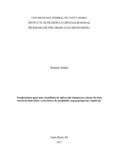| dc.creator | Damo, Homero | |
| dc.date.accessioned | 2018-07-25T19:59:18Z | |
| dc.date.available | 2018-07-25T19:59:18Z | |
| dc.date.issued | 2017-03-16 | |
| dc.identifier.uri | http://repositorio.ufsm.br/handle/1/13911 | |
| dc.description.abstract | This work aims to study the metaphysics of individuals and how it would be possible to create
a metaphysics without the use of them. In this work we first begin with a study on the
traditional substrate theory in Locke. Next, we will present Hume’s critique of this model and
the idea of our preference for a more parsimonious ontology. Also in this part, we will
comment a little bit on the nature and identity of properties. Then, in the second chapter we
will present the four versions of the bundle theory. As the name itself says, we will present
four interpretations of the bundle metaphor in texts by Van Cleve and Casullo. Each version is
presented in it’s main features. The first version of the bundle theory claims that bundles of
properties are sets, the second version claims that an individual emerges from the coinstantiation
of properties, the third version claims that there is no individuals and the fourth
version proposes that there are bundles of bundles. In the third chapter we will deal basically
with the problem of the identity of the indiscernibles. We will comment a famous Max
Black’s for this purpose. The problem of the identity of the indiscernibles was already
mentioned in chapter two, but in this chapter it is worked deeply. In the third chapter we will
comment Zimmerman (1997) and O’Leary-Hawthorne (1995) to present the idea of immanent
universals. We will try to show how this conception of universals would solve the problem
presented by Black. Finally, in the fourth and last part we present Russell’ bundle theory. In
this part, the most extensive of this work, we deal, firstly, with the problem of one over many
and its relationship with the nature of universals, secondly, with the problem of numerical
diversity, thirdly, with the ontology of events, fourtly, with the problem of analyticity, and
fifthly the epistemology of the bundles. | eng |
| dc.description.sponsorship | Conselho Nacional de Pesquisa e Desenvolvimento Científico e Tecnológico - CNPq | por |
| dc.language | por | por |
| dc.publisher | Universidade Federal de Santa Maria | por |
| dc.rights | Attribution-NonCommercial-NoDerivatives 4.0 International | * |
| dc.rights.uri | http://creativecommons.org/licenses/by-nc-nd/4.0/ | * |
| dc.subject | A teoria do feixe | por |
| dc.subject | Universais imanentes | por |
| dc.subject | Metafísica dos indivíduos | por |
| dc.subject | The bundle theory | eng |
| dc.subject | Immanent universals | eng |
| dc.subject | Metaphysics of individuals | eng |
| dc.title | Fundamentos para uma metafísica de universais imanentes: um esboço de uma teoria de indivíduos como feixes de qualidades espaçotemporais repetíveis | por |
| dc.title.alternative | Groundwork of the metaphysics of immanent universals: outline of a theory of individuals as bundles of repeatable spatiotemporal qualities | eng |
| dc.type | Dissertação | por |
| dc.description.resumo | Este trabalho tem dois objetivos: estudar a metafísica dos particulares e como seria possível
criar uma metafísica sem o uso deles. Começamos com um estudo da teoria tradicional do
substrato em Locke. Em seguida apresentaremos a crítica de Hume a esse modelo e nossa
preferência por uma ontologia mais parcimoniosa. Também nessa parte, comentaremos um
pouco sobre a natureza e a identidade das propriedades. Em seguida, no segundo capítulo,
apresentaremos as assim conhecidas “quatro versões da teoria do feixe”. Como o próprio
nome já diz, apresentaremos quatro interpretações da teoria do indivíduo como um feixe de
propriedades. Nos apoiaremos nos textos de Van Cleve (1985) e Casullo (1988). Cada versão
é nos seus aspectos centrais. A primeira é sobre feixes como conjuntos de propriedades, a
segunda sobre coinstanciação de propriedades, a terceira é sobre a ausência de indivíduos
acima e além das propriedades e a quarta é sobre feixes de feixes. Logo em seguida, no
capítulo terceiro, trataremos basicamente do problema da identidade dos indiscerníveis, e
faremos nossa exposição a partir de um famoso artigo de Max Black (1952). Esse problema
aparece citado já no capítulo dois, mas nesse capítulo ele é trabalhado com um pouco mais de
profundidade. Ainda neste terceiro capítulo, apresentaremos a ideia de universais imanentes
nas linhas de Zimmerman (1997) e O’Leary-Hawthorne (1995), e como essa concepção de
universais resolveria o problema apresentado por Black. Por fim, na quarta e última parte
trabalhamos com Russell. Nesta parte, a mais extensa, tratamos do problema do um-sobremuitos
e sua relação com a natureza dos universais, o problema da diversidade numérica, a
ontologia dos eventos, o problema da analiticidade e a epistemologia dos feixes. | por |
| dc.contributor.advisor1 | Santos, César Schirmer dos | |
| dc.contributor.advisor1Lattes | http://lattes.cnpq.br/4518010795079534 | por |
| dc.contributor.referee1 | Brzozowski, Jerzy André | |
| dc.contributor.referee1Lattes | http://lattes.cnpq.br/7938441548737592 | por |
| dc.contributor.referee2 | Sautter, Frank Thomas | |
| dc.contributor.referee2Lattes | http://lattes.cnpq.br/2804652028967760 | por |
| dc.creator.Lattes | http://lattes.cnpq.br/2742294966416781 | por |
| dc.publisher.country | Brasil | por |
| dc.publisher.department | Filosofia | por |
| dc.publisher.initials | UFSM | por |
| dc.publisher.program | Programa de Pós-Graduação em Filosofia | por |
| dc.subject.cnpq | CNPQ::CIENCIAS HUMANAS::FILOSOFIA | por |
| dc.publisher.unidade | Centro de Ciências Sociais e Humanas | por |



